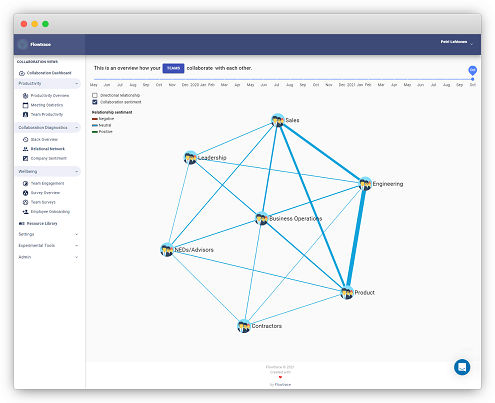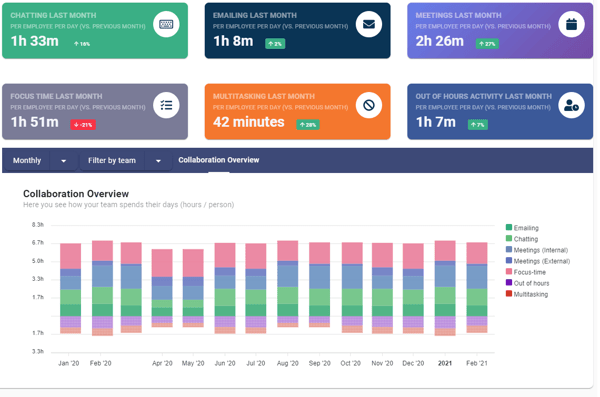In an ideal world, we want our teams to be more productive, but how would we know they were if we didn't measure it? Merely seeing an increase in the output of work doesn't mean more valuable work is actually being done.
Truth is, discovering how to measure productivity of your teams can be a mammoth task, especially in an increasingly remote workspace. Given the abundance of tools knowledge workers use every day, it can be hard to find where to begin!
In our short guide, we go through the five different methods of measuring productivity for teams, so that you can evaluate if there are any issues with processes and empower them to do their best work in the future.
What is team & employee productivity?
Most traditional definitions of productivity will describe it in its simplest form:
Output ÷ Input = Productivity.
Sounds simple: The amount of work completed by your workers should be divided by the number of hours they put in, and you'll arrive at a magical measurement of how productive an employee or team is.
However, the above formula doesn't factor in a range of variables, the most important one of which is the quality of the work being delivered.
If you start counting how many calls your team is making, that's not measuring productivity - you're simply tracking the number of calls your team can complete in a set period. In our books, measuring productivity is a different beast.
Rather than keeping track of inputs, track your team's goals and KPIs, and whether they're reached every quarter. If they are and there's alignment across departments, it's a sign of a well-built workflow.
Here at Flowtrace, we like to think that productivity is the alternative to misplaced efforts, and if you want to know how to increase or measure producitivity, you need to look beyond singular inputs and look for potential areas of friction.
Rather than keeping track of inputs, track your team's goals and KPIs, and whether they're reached every quarter.
Why is measuring productivity important?
Put bluntly, the lack of productivity among your team costs money to the business. And while we all have good intentions and make small efforts to strive to achieve it, it's rarely effectively measured.
The side effects of poor business productivity range from employee disengagement, lower work output, lack of focus time, and the lack of communication with other teams. But most (if not all) can be addressed and turned around if you spot them in time.

THE 5 METHODS OF HOW YOU CAN MEASURE YOUR TEAM’S PRODUCTIVITY

When your workforce can complete all or most of their job remotely with the help of online tools, there are ways of how you can measure how well their time is spent on different projects and activities.
Here, we're specifically talking about knowledge workers, including engineering teams, marketers, sales team members, support and customer success heroes, and other teams.
We call this the “digital exhaust” or rather, the digital footprint of digital tools, and you can use it to help you measure team productivity.
#1 Collect insights from your team through 1:1s, 360-degree feedback & assessments
While collecting feedback can be quite a resource-heavy way of measuring productivity for teams, it's worth doing it regularly.
Having candid conversations about productivity, internal and external processes, as well as discussing relationships with other teams can all prove to be an effective way to evaluate any immediate or long-standing issues that need to be addressed.
There's a mountain of advice on how to host effective 1-1 meetings and how to digest and analyse all feedback you receive. Our main bit of advice here is to listen carefully before jumping into any conclusions - the initial dissatisfaction is usually the symptom of an issue and not its root cause.
#2 Measure your meeting culture (& quality)
Having too many meetings can be a real productivity killer. We've all sat in meetings that we felt we could add very little value to. Similarly, some meetings can be avoided completely with better planning and asynchronous communication.
Remember, all interactions in the workplace are about quality, not quantity (except money in the bank account, of course 😅).
If you're looking to see if your team is spending too much time in meetings, keep close attention to events with a large number of attendees or ones where the whole team is present.
If you work for a company that champions transparency, everything by default should be transparent, so calendars should be easily accessible. Finally, you can ask if your team members feel they spend too much time in internal discussions.
If you're also looking to improve the quality of your meetings, we've found that multitasking should be avoided as much as possible (unless it's a collaborative meeting where the purpose is to work together).
Want to cut your meeting time? Ask your team to focus!
Having joined a new team as a COO, I saw half the company in a management meeting where every person had a laptop in front of them. It was a 2-hour meeting that's essentially a status update. What I suggested to do instead was to share the status update before the meeting and ask team members to bring a notepad. The result? We cut the meeting time in half and made everyone feel a lot more fulfilled!

#3 Measure how much you've moved the needle towards key business metrics since the last period
Every business has important business metrics to track. In subscription-based businesses (SaaS) some include Monthly Recurring Revenue (MRR) and Retention Rate, for e-commerce brands, it's Sale Conversion Rates and Shopping Cart Abandonment rates. This needs to be complimented by management metrics which tell you the story how your organization is performing.
To measure whether your employees are productive, you need to know how much of the work they do day to day contributes to overarching business goals.
If you use one of the popular goal-setting techniques like OKRs or have an extensive growth plan that spans a few years, this will be easy.
If you don't, look to the key projects and KPIs across the organisation. Check how many of them were achieved and how resource-heavy they were.
Remember, multi-tasking and looking busy is NOT being productive. Similarly, starting early and finishing late is not what makes your employees efficient.
Big, meaningful projects can't be accomplished if your team is focusing on small, less impactful tasks in their everyday work. But if they're swamped by admin, this could be incredibly hard to notice (see our point below to help with that).
#4 Explore built-in analytics in your communication & collaboration tools
Your team probably uses an instant-messaging app like Slack or Microsoft Teams to share information and a project management tool like Atlassian/Jira or Asana to record and share their work.
There are some built-in analytics reports that you can use in each of these tools to understand how much work is created, how the tool is used across the organisation, and, of course, whether there are any areas where the teams are falling behind.
In the case of Slack, the Slack analytics dashboard gives you insights into how Slack is used in your organisation. You can find out how many members are active on a weekly or daily basis as well as specific channel and conversation metrics, right down to how many files are being uploaded and the ratio of messages between public and private channels being sent across the workspace.
However, while Slack channel statistics do help you understand team collaboration, these reports won't provide the big picture of productivity at your company.
#5 Use a dedicated tool to measure cross-team collaboration & productivity
With the colossal rise of remote work and online collaboration in 2020's, teams across the world are finding themselves in a flurry of different types of communication and productivity tools, but the problem is that all of these tools rarely speak to one another effectively. When used by different teams, they can actually contribute to creating information silos across the organisation.
With this rise, there's a brand new segment of tools emerging called company analytics. This product category exists in the intersection of Productivity, People, and Interaction Analytics tools, and combines insights on how well your teams work internally and how their relationships are formed with external parties.

Our collaboration diagnostics tool, Flowtrace is similar to what the big players offer including Microsoft Viva Insights and the custom, in-house built dashboards by Business Intelligence (BI) tools like Looker. Big differentiator is that we are built for tech industry with complete self-service option.
These tools combine multiple data sources to evaluate productivity and efficiency levels across the whole organisation and can feel like a major upgrade to the built-in analytics of individual communication and productivity tools.
If you'd like to take a scientific approach to understanding and optimising your employee and time allocation in a remote-first world, explore our productivity analytics tools.

Are you ready To Measure Team productivity?
It's likely that you already have what you need to start measuring how productive your team is in their day-to-day work. However, you need to be mindful of the fact that you can only get the big picture if you put multiple data sources together. It can be done manually, but it's much faster with a dedicated tool.
The more puzzle pieces you have, the easier it will be to highlight pressing issues like disengagement, siloed teams, or an excess amount of admin work that keeps your teams busy without contributing to the broader business goals.
Thanks for reading our article!
Are there any methods of measuring productivity that we missed? If so, please share them with us in the comments or on social media.
